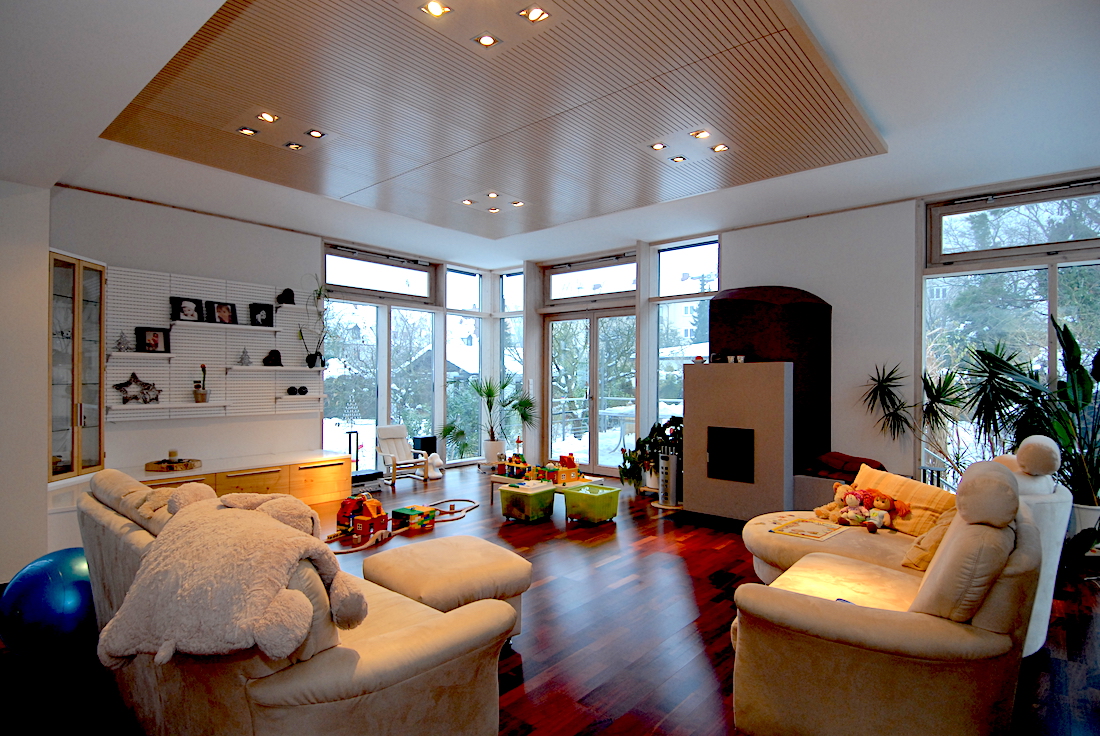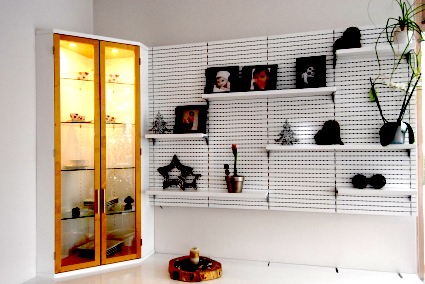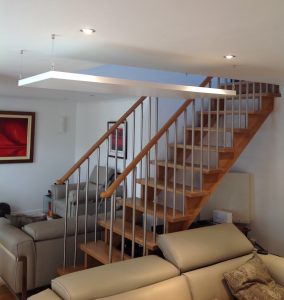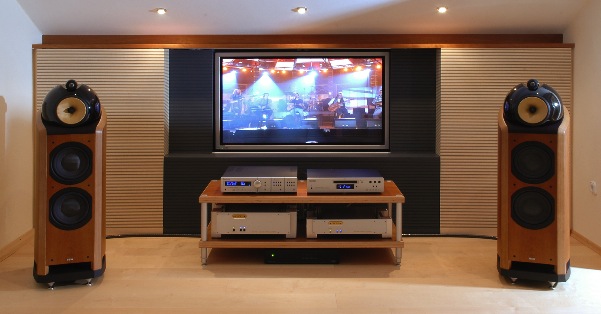Is this a nightmare room?
With more than 60% glass – more off to the right – and hardwood flooring this room would normally echo badly, making conversation (let alone music) quite difficult, and impossible with a number of people talking. To make matters worse it is open-plan through a wide opening to a large kitchen, yet another potential echo chamber.

What makes it a really comfortable living room with an easy ambience is… can you spot it? The highly-specialised veneered acoustic lighting panel on the ceiling and the back of the bookshelves on the far wall. That’s all – in a room of 48sq m.
These LeadingEdge panels are radically different from conventional frequency absorbers:
- they absorb excess energy across almost the whole frequency spectrum, not just at spot frequencies, a technique that can badly upset overall tonal balance
- they are very efficient, needing less surface area than conventional treatments, therefore considerably lessening visual impact
- their effectiveness works as the square of the room energy, ie double the sound and absorption is four times more

Panels can be made to fit specific spaces and even small areas are effective
A room treated with LeadingEdge panels is noticeably quiet and calm. By contrast you will have been in restaurants with hard floors and untreated walls that make conversation very hard.
No need for heavy curtains and fitted carpets, all of which can make the room lifeless. Especially for music, the correct ratio between absorption and dispersion is essential to preserve frequency balance.
Room layout and design
Most people listen to music in one of the family house rooms. There are things you can do to improve its characteristics without upsetting other family members and this advice may help: Speaker placement
If you are lucky enough to start from scratch the measurements given here, based on the Golden Ratio, will give you a room that will have no standing waves or bass problems. It’s a “clean room” as far as reproducing music is concerned.
Dealing with ‘old’ sound
As you play music ‘old’ sound energy from a few milliseconds earlier bounces between all the surfaces in your room – walls, ceiling and floor – then clashes and intermodulates with the ‘new’ sound that’s just emerged from the speakers.
Intermodulate? – or interact, to make a change. Think of waves that break on a beach and meet the previous retreating wave. They ‘intermodulate’ and the clash breaks up the free movement, causing the new incoming wave to lose a lot of its energy. Now think of the damage caused as the old and new sound meet and interact.
Result: the room itself destroys an amazing amount of fine detail and musical information which cannot be recovered with a change of electronics.
The LeadingEdge panels control this old sound, with thousands of micro-perforations on the panel surfaces that create turbulence as air particles pass, causing ‘aerodynamic drag’ and energy is absorbed into the panels’ internal honeycomb. It’s like having a volume control to make the room quieter.
These diagrams help to explain the mechanism: room acoustic principles
Aerodynamic drag removes unwanted energy across the whole audio spectrum and is far more effective than conventional foam-filled panels that work selectively only at narrow frequency bands.
Significantly, aerodynamic drag increases with the square of the velocity – when the velocity doubles, drag increases four times! In this way, the LeadingEdge panels are ‘reactive’, the more loose energy bouncing round the room, the more effective they become.
Panels are available in different sizes and three standard finishes: Cherry, White, and Light Oak though almost any finish can be ordered to match décor. Panels can be free-standing and stored when not required – they are not heavy – or fastened to the walls and made into a feature with a specialised veneer. Where domestic circumstances allow a most effective solution is to suspend panels from the ceiling, where they absorb energy from all directions.

The company, Kaiser Akustik based in Bavaria, has installed acoustic treatments in conference halls, boardrooms and public buildings but also in private homes, mainly in Germany and Austria. Here is a link to their site Kaiser Akustic that shows examples of jobs and the inside of the factory. Some examples of installations are:


A significant part of our service will include advice on the most unobtrusive yet effective way of integrating them into the room. This acoustic technology is very much more sophisticated than the usual absorbent foam approach, or inserting yet more soft furnishings as mentioned above.
Simple steps to improve sound in your room
Often some simple changes can transform your enjoyment.
Room acoustics are critically important for relaxed enjoyment of music – create sound in a room and the room responds with its own character. Unless treated, hard surfaces will reflect high frequencies to create an over-hard, edgy sound. Corners – wall-to-wall, wall-to-ceiling and wall-to-floor – can over-emphasise bass.
If you feed in more acoustic energy, as music volume increases, listeners may say ‘that’s too loud’ and bass becomes bloated, masking the performance.
In a problem room you can be left with a volume-related ‘letter-box’: lower the volume and the sound lacks energy and involvement while higher becomes unpleasant. If you ever think ‘that’s too loud’ there’s almost certainly RFI and intermodulation distortion at work within the equipment as well. Quiescent Component Couplers, mains treatments and Loudspeaker Modules will tame those problems.
After that, if the room is well-behaved there should be no limitation, either way, on music volume.
One of the most critical factors in making a system perform well in a room is positioning – the speakers, the listening spot and, one that’s often overlooked, the equipment rack – not in a corner, please! With our advice customers have completely transformed the sound and their enjoyment.


